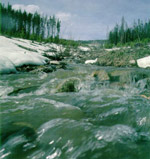
The Big Water Picture
Sometimes we get so caught up in the day-to-day that we fail to see the magnitude of the importance of our efforts or of the field we work in. Let’s pull our heads up from our tasks and take a look around at the Big Picture.
Here are some interesting facts, trends, and developments from a variety of sources.
Size of the wastewater problem. “Globally, 2 million tons of sewage, industrial and agricultural waste is discharged into the work’s waterways and at least 1.8 million children under five years old die every year from water related disease, or one every 20 seconds.”
Hospital impact. “Over half of the world’s hospital beds are occupied with people suffering from illnesses linked with contaminated water…”
Comparison with wars and other forms of violence. “…more people die as a result of polluted water then are killed by all forms of violence, including wars.”
Return on investment. “According to a recent report from the Green Economy Initiative, every dollar invested in safe water and sanitation has a pay back of US$3 to US$34 depending on the region and the technology deployed.”
Food production. 70-90 percent of the available fresh water is used to produce food. Much of this water returns to the ecosystem with additional nutrients and contaminants.
Day-to-day illness. Approximately 88 percent of all diarrhoeal incidents are related to unsafe water and poor hygiene.
Water availability. Ninety-seven point five percent of all water is salt water. Thus, only 2.5 percent is fresh water. Seventy percent of the fresh water is locked in Antarctic and Greenland icecaps. Approximately 29 percent of fresh water is soil moisture, or too deep underground to be accessible. Thus, only 1 percent of fresh water is available for human use. In other words, for every 100 gallons of water on the Earth, only 0.25 gallons is usable by people.
Water usage. The top three water users for agriculture are North America, Oceania (South Pacific islands including Australia and New Zealand), and South Asia. The top three domestic water users are Europe, North America, and Oceania. Europe and North America are almost tied for industrial water use, followed by Oceania, Asia (not including south Asia), and Latin America.
North American death rate. Here is a fact that all of North America (including Mexico) can be proud of. According to a report from UN-HABITAT, fewer than 15 people of every 100,000 died from waterborne illnesses. This is the lowest ranking possible.
Agricultural usage. The approximate gallons of water needed to produce 2.2 pounds (1 kilogram) of a food product is 11.9 for rice, 5.28 for soybeans, 4.00 for wheat, 1.32 for potatoes, and 1.32 for corn. This compares with 494.0 for beef. This is approximately 5.5 times the combined total for rice, soybeans, wheat, potatoes, and corn.
Industrial usage. This category uses between 5 and 20 percent of total water usage.
Desalination. Saudi Arabia is the leader in desalination capacity (no surprise). But did you know that the United States is in second, followed by the UAE and Kuwait?
Impact of United States bottled water usage. “In the United States, it is estimated that the production of the bottles alone requires 17 million barrels of oil a year and it takes three liters of water to produce one liter of bottled water.”
Water related diseases and contaminants. The Centers for Disease Control lists more than 100 water related diseases and contaminants. Some of these are among humanities most known diseases, including Cholera, Typhoid Fever, Malaria, West Nile Virus, Yellow Fever, Dengue Fever, and others. Many of these diseases, such as Cholera and Typhoid Fever, have been stopped by modern water treatment.
Water cap and trade? We have all heard about the concept of carbon cap and trade. Could this be the future of the water industry? In London, the Carbon Disclosure Project has led to another effort, The Water Disclosure Project. According to Steve Maxwell's "Water Market Review 2010 Update and Executive Summary," the new project “will gather data to inform and alert concerned investors as well as governments and the general public about corporate water usage and behavior." The idea is that “by forcing businesses to improve the measurement of their water usage, efforts such as this hope to also incentivize better management of water.”
When you look at the data, North America is doing an exceptional job at keeping the waters clean and protecting the public heath. All of you operators in this “Silent Service” should be proud. However, we are in jeopardy of losing all of these accomplishments. Decaying infrastructure, increasing population, decreasing global water quality, and the impacts of global warming will make water scarcer and more expensive to treat. That is why we need to listen to the experts and dramatically increase the amount of money invested into our field.
Posted by Grant Van Hemert, P.E., Schneider Electric Water Wastewater Competency Center on May 11, 2010